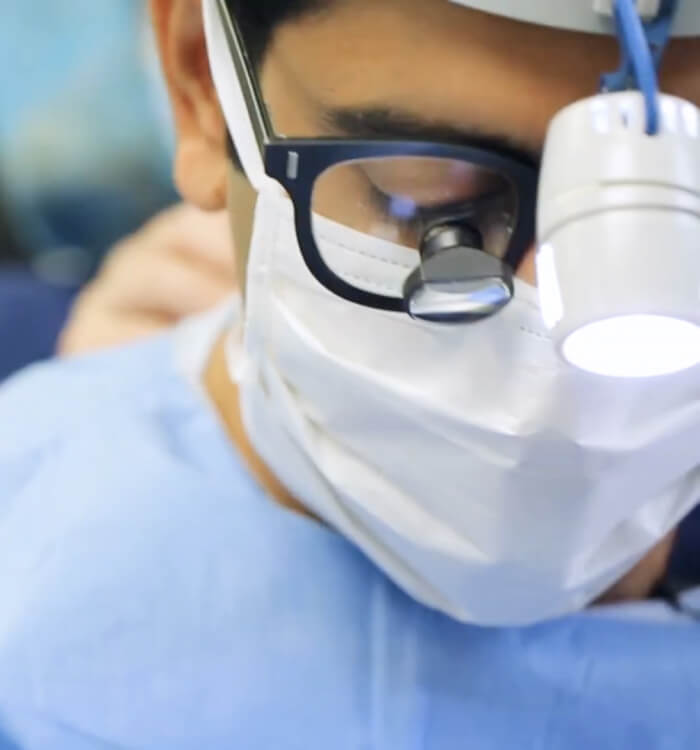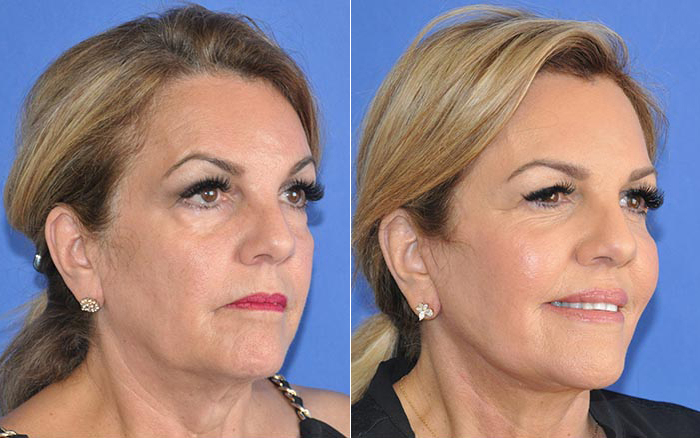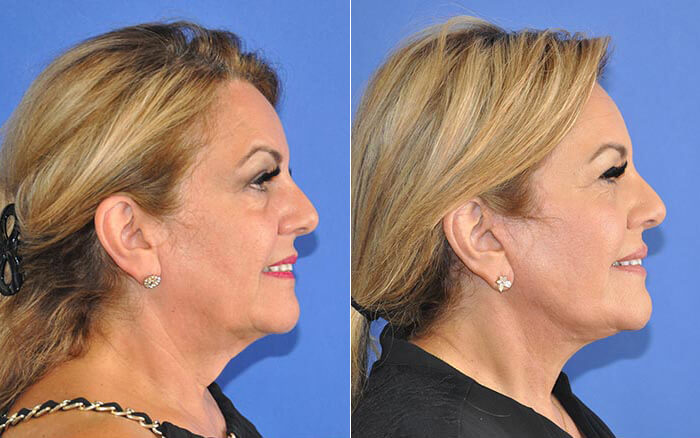Facelift
Table of Contents

What Is a Facelift?
Mini Facelift
Benefits

Am I a Good Candidate?
Overview of the Facelift Procedure
Dr. Dhir works with each patient closely, ensuring an attentive, patient-centric approach to cosmetic surgery. At every point of the process, he provides support and information to ensure patients can make their decisions with comfort and confidence
What are the main facelift techniques?
- Mini Facelift: This milder version of the facelift uses smaller incisions. It works best for patients who have moderate signs of aging but want a less intensive approach. The result duration is more limited, with patients seeing benefits for 5 to 8 years in most cases.
- SMAS Facelift: This is the gold standard facelift, which involves repositioning the sheet of muscle and tissue under the skin. This creates a natural look and avoids the stretched appearance of older facelift methods.
- Deep Plane Facelift: This more advanced facelift technique involves repositioning the SMAS and deeper tissues. It is more intensive, but it provides exceptional results that also last the longest.
Consulting
Preparing
There are a few steps that will have you ready. These can vary for some patients but mostly will include:
- Not eating or drinking before the procedure
- Stopping certain medications (such as blood thinners)
- Avoiding nicotine and some herbal supplements
- Readying your home for recovery
- Planning for someone to drive you home from surgery
The Surgery

Recovery & Results of Facelift

Book Your Consultation Today
Frequently Asked Questions
How much does a facelift cost?
Each facelift procedure is tailored to the patient’s needs, goals, and facial structure. The chosen techniques and overall complexity are the main factors when determining the cost of the procedure. While any blanket quote would be inaccurate, we always provide a clear, personalized quote after building your procedure plan. This quote requires no commitment, and we can go over each detail to ensure each cost element is clear.
Patients may also choose to finance a surgery. Facelift financing options allow patients a more flexible approach to cover the costs of their procedure.
Is a facelift painful?
Will a facelift leave a scar?
Each surgical facelift technique involves creating incisions, which will heal as scar tissue. However, that is not all there is to it. Dr. Dhir strategically places each incision so that any scarring is hidden. Furthermore, he keeps incision size to a minimum and creates them smoothly to follow the natural contours of your unique facial structure.
Keep in mind that scars also improve over time. If you take good care of the surgical sites during recovery, your incision scars should heal nicely. Over time, you may forget they are even there. Only your rejuvenated appearance will be all you notice.
Can a facelift eliminate wrinkles?
When the skin is stretched during a facelift, it smooths out many wrinkles. This creates a powerful visual change that emphasizes facial contours. However, some fine lines can remain, especially in places of high facial movement. Nonsurgical treatments like microneedling can work as effective supplements to a facelift to further develop a youthful look.
How long do the results last?
Facelift results can last up to 10 years for many patients. However, a lot of factors are at play here. Patients who take a few extra steps will be able to prolong their results, enjoying a refreshed appearance for a decade or more. A few things to know about facelift result duration include:
- Maintaining a healthy lifestyle will help you keep up your results. This includes staying hydrated and eating a balanced diet.
- Avoiding factors that age your skin will work in your favor. Top aging elements include excess sun exposure and smoking.
- Nonsurgical treatments (like microneedling) can help maintain skin quality and boost collagen production. This helps keep good skin texture and elasticity.
Can I have a second facelift?
Patients certainly can have a second facelift procedure. Such a procedure would be considered a revision facelift. Most patients have a second facelift if their initial results begin to fade or they are dissatisfied with a surgeon’s outcome. As long as a patient still meets the candidate requirements, a repeat procedure is always possible (and can be beneficial).
When having a second facelift, you want to ensure you work with a highly skilled surgeon. The first facelift only involves your natural tissues. However, a second facelift will need to take into account any scar tissue or previous adjustments.
Is a facelift right for me?
Choosing the right cosmetic procedure can feel intimidating. This is all the more true with surgery, as the results last longer. The main thing a facelift addresses is skin laxity. Jowling, wrinkling, and sagging skin can all be addressed in a single procedure. However, many patients may only have milder concerns. In these cases, there is nothing wrong with starting with nonsurgical rejuvenation. However, if you have moderate to significant signs of aging, a surgical approach offers the surest way to see satisfactory results. But that is what the consultation helps with. Dr. Dhir discusses your concerns with you and then provides key recommendations to get the results you want.
How safe is the procedure?
As with any surgery, a facelift can involve some risks. However, you can promote a safer experience by only working with a skilled, qualified surgeon. Some key ways to reduce risk and create a smooth experience include the following:
- Ideally, work with a facial plastic surgeon. While general plastic surgeons offer this procedure, a facial plastic surgeon has dedicated their career to understanding the face’s complex structures.
- Choose a board-certified plastic surgeon with a track record of successful procedures.
- Follow all your post-procedure instructions, which are designed to improve safety.
- Avoid smoking or other factors that could inhibit your recovery.
How to choose a facelift surgeon?
Choosing the right surgeon can make all the difference. However, we know it can feel overwhelming trying to make this big decision. Some key factors to look for include the following:
- Your surgeon should specialize in facial plastic surgery.
- Before-and-after photos that showcase the surgeon’s work.
- How do you feel when communicating with the surgeon? Do they genuinely care about you and your needs?
- Do they have positive reviews from previous patients?



